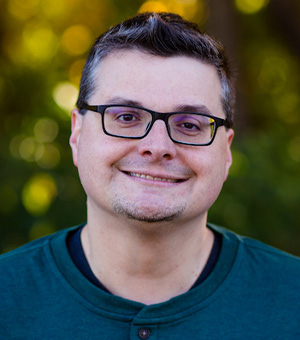Interview with Robert Smelser, Accessibility Expert and eLearning Designer
Q&A with Robert Smelser, who is presenting at the 2023 Design+Accessibility Summit for CreativePro


Robert Smelser is an experienced graphic designer and certified accessibility expert.
Robert is also speaking at our upcoming online event, The Design + Accessibility Summit, which takes place November 14-17, 2023. We thought it would be fun to get to know him better with some Q&A.
What’s the biggest misconception about creating accessible audio and video?
The biggest misconception about audio and video accessibility has to do with the scope of accommodations. I might look at items like transcripts, captions, and descriptive audio and think of them purely as accommodations for hearing and vision disabilities. That should be enough to make me care about accessibility, but I think it’s also important to acknowledge the wider impacts of accommodations like closed captions and descriptive audio.
- Closed captions can help people with auditory processing disorders — individuals who can hear just fine, but their brains don’t always assemble the phonemes they hear into immediately recognizable patterns. They can also help with anyone comprehending audio in a noisy environment, in a learning setting, or with any device that has subpar speakers.
- Descriptive audio can help anyone who has a hard time processing visually busy information, giving them a clear indication of what’s important in the video. It can additionally benefit people with low vision. Perhaps they can see the screen but can’t see everything with equal clarity or definition. Descriptive audio can help cue them in on what they may visually miss.
Do you have a favorite tip, trick, or tool that makes your accessibility work easier?
Here are a couple tips I recommend for creating some of these accommodations:
- Write a script. If you proactively write out what you or others are going to say and stick close to it, then you will have already finished a big chunk of the work for creating closed captions or a transcript and will reduce your reliance on auto captions.
- Edit auto-captions if you must use them. Most online platforms, like YouTube and Vimeo, let you download the captions they generate or edit them on the site. This gives you a chance to correct any mistakes the voice detection software may have made, which makes your content more understandable.
There is a plethora of tools for transcribing your speech in a live setting. I personally recommend MacWhisper, which has both free and paid versions. Additionally, recent versions of macOS and Windows have included dictation software, but you have to know where to look.
- On macOS, you can launch the Dictation app by assigning it a shortcut in the Accessibility section of the Settings app. It will start typing in whatever document or text field has focus.
- On Windows 10 or 11, Win+H will launch the Speech Dictation app. It will start typing in whatever document or text field has focus.
What’s your best suggestion for anyone new to the world of accessibility?
If you’re new to the world of accessibility, my advice is to take things one step at a time. You don’t need to become an expert overnight, and you never have to be an expert at all the things. Where does accessibility intersect most closely with your work? Start there.
- Look up sessions like those offered by CreativePro or LinkedIn Learning that are relevant to your work.
- Find accessibility experts and advocates through events like these and other learning platforms and connect to them through the social media handles they share.
- Start a tab group or bookmark folder to save things you run across that might be useful or that you may want to dive into later.
Like any professional network, it can take time to broaden your accessibility resources, but patience, bookmarking, and connections will eventually give you a wealth of resources.
What are you most excited to share in your upcoming session?
I’m so excited to connect with all of you as a peer. I started learning about accessibility on the job, as I’m sure many of you have. I’m looking forward to us learning together because I’m confident that some of you will come with practices, tools, and insights that will be new to me. Finally, I’m looking forward to making new connections that will benefit mutual growth in accessibility. Every time you make something more accessible, you make things better for millions of people around our globe. Our work makes the world a better place, and I can’t think of anything better to say about accessibility.
This article was last modified on September 27, 2023
This article was first published on September 27, 2023



